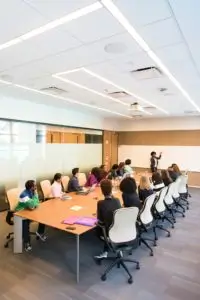Nowadays, we don’t see students on the road going to their schools or universities to get educated. This case has been especially prevalent in today’s world since the outbreak of the coronavirus. Before the outbreak, of course, there has been virtual schools that provided online education for thousands of students, either full-time or part-time. But the problem with these schools always been the same thing: engaging students with digital learning, low motivation, and satisfaction after a certain time passes. So, digital learning is not something new.
In virtual learning, there is no need for the presence of the students and teachers, no more physical classrooms or meeting students and teachers face-to-face. All you need to is to wake up in the morning, get ready for the online class (of course, a very limited number of students put on something decent. Even the teachers put their comfortable pajamas), and open your laptop to connect to your online class on the Skype, Zoom, Discord, etc.
The aim of this article is to review the methods by which instructors can increase students’ engagement in virtual classes. Before that let’s see some of the main characteristics this type of learning has that made it popular.

What are the characteristics of digital learning that made it so popular?
It has been reported that more than 300,000 students were enrolled for virtual learning (NEPC, 2017, 2018). We are not talking about high schools. I am talking about bachelor, masters, and doctoral degrees. These figures are pretty significant. So why students should enroll in these classes, even for their higher education? There must be some characteristic that made them so popular among the students.
1) The ability to learn from everywhere. The place, color, or religion don’t make a difference.
Education is for everyone. The great political leader “Nelson Mandela” once said that:
“If you want to change the world, educate your children. Education is the most powerful weapon.”
Education is not just for certain kids. Your religion, nationality, or color of skin won’t make a difference. Virtual learning makes education from high distances possible. Whether you live in China, Korea, or the UAE. All you have to do is sign up, pay the tuition and you will be ready to be a student of high-rank virtual schools they accept anyone high-rank universities such as Rutgers University-New Brunswick, Thomas Jefferson University, and the University of Delaware).
This option can be good for those who lack the proper schools and universities and they want to make a better life for themselves by following a career, to have a constant income one day in the future.
2) The knowledge will be constantly updated
In traditional education, students had to access school libraries to find what they are looking for. The books can sometimes be outdated, containing not proper information for what students seek. But not we have seen a transition from physical libraries to digital ones.
Through virtual learning, you would access more information. Also, the students will not be alone in their online class, meaning that they can ask for help from their classmates from other countries that can give them the information needed. You are still classmates with a difference that you are hundreds or thousands of miles away from each other.
This is also true about teachers. Just because they are not at school in person, it doesn’t mean that they will lose touch with each other. Teachers can also face some challenges in their online classes. What is the solution? Technology has come to their aid. All they need to do is to contact one of their peers or colleagues and exchange information with them.
Right now, some countries are unable to provide proper education for their children. However, we hope that digital education can affect this situation, improving the learning, experienced, and skills to a better future for the next generations.
3) Learning how to collaborate with other students
Group work in online classes can be a tough thing since they are not present at the class to see each other face to face. Cooperation and teamwork are the two most crucial skills that must be learned and this can be accomplished by digital learning. There are educational tools such as “Bingiel” to teach the students how to do their activity in groups. This tool is equipped with a “gamification” feature and using this feature, the groups can play games during their breaks. To win the game, they have to trust and rely on each other.
In addition, give your students a project or a topic to work on. Don’t make them isolate themselves more than it is right now. Assign certain partners to them. Each student has a different and unique skill. Some know computers better than others, some good at working with applications such as Microsoft Office Word, PowerPoint, etc., and some are good at making graphics.
Collaboration and making groups are good ways to combine all of the unique skills and perspective to bring out the best project. In addition, group projects cad result in binding and friendships that will free them from isolation. Therefore, they will feel comfortable after a while both with you and other students.

What can a teacher do to push students to engage in digital learning?
Online classes and the methods used to teach must be different from traditional classes. The only difference is that the class has moved from schools to the students’ room and house. So whatever methods that teachers used to carry out to engage students in the class must be modified. In traditional classes, the teacher was used to carrying out methods such as:
- Role-playing
- problem-solving
- Team-work and creating groups, etc.
In digital learning, more engaging activities than traditional classes must be utilized. These methods must be properly designed for students to better connect with their peers and learning material.
It must also be mentioned that virtual learning can be quite challenging for students. They may feel unfit for the online class and they don’t see their teachers face-to-face to receive help from them. How can teachers help the students, who are leaving miles away, with these conditions? How can teachers solve their problems? The teacher must find ways to excite their students in order to bring them into class. Or else, what is the point of holding an online class when no one attends the class?
In the following section, we would like to help teachers on how to level up the engagement of their students.
1) Find a common ground with your students
An online class is an environment that the teacher will not see the students face to face and talking with them will only possible through the phone or laptop screens.
Usually, the reason behind the attendance of students is to meet up with a close friend or their lover. I have seen kids who joined some social groups in the school just to get close to the person they have a crush on.
But during the lockdown, they have been staying at home with no way to see their friends. What must the teacher do to bring kids to the class? Humor, jokes, memories of funny and interesting stuff can be a great start.
You have to bring your students to the conversation. You are not alone, you are with maybe 15 to 20 students at the same time. An online class is not about giving lectures and going back home anymore. Tell an interesting memory that will make them listen to you. They will join in the conversation by telling you another memory of themselves.
You can create group chats of four to five students and talk with them. Ask for what they like to do if they were on vacation right now. Ask them what their favorite movies, music or food are. It will take time but they will come around. Have a little patience.

2) Feedback must be part of the online learning classes
As you know, isolation made a lot of effect on the students, reducing their motivation and incentive to carry on their careers. They believe that their life has reached a dead end since coronavirus spread. They are no eager to continue their classes or they attend less motivated. I don’t blame them. They are young and they haven’t met the real world yet.
Two groups can have a crucial effect on the students’ motivation: parents and instructors. Students will not be able to self-motivate themselves. Therefore, the students will need all the help they can from teachers and parents.
Parents must always keep their contact with the teacher to receive guidance from them when encountering any challenges. Teachers will get a special education in this regard. Both must act together to motivate the kids.
If the kids are doing great at the class, both teacher and parents must appraise their efforts. If an individual completes a task given in the workplace in a fast manner, he/she will get a raise or promotion. In the school environment, the teacher must give them points that will increase their motivation to carry on their efforts. Related to parents, they can hold on to the promise that they made to their kids. For example, a family game night or a gift.
3) Give your students a degree of control
This method may not be loved by some teachers. But we are assured that it will work, it has worked before.
Assignments can keep students busy for a couple of days until they finish it. But as all teachers experienced, not all the students are eager to do their assignment mainly because the topic given is boring and the student doesn’t show any interest in completing the topic. Or when he/she starts it, god only knows that when will it be finished. Give them a degree of control over the topics. You will see that they will finish the assignment with a quality that you couldn’t imagine.
Also, remember that some students are shy and they prefer not to talk about their issue. In the teachers’ case, however, some teachers are so strict that they don’t give their students the opportunity to talk. You as the teacher must give the freedom to the students to talk. Are you waiting for the end of the semester to see the results of the students and then help them fix those issues? Don’t make that mistake. Act now. Give them time to talk. You may feel amazed after students tell you what they fear and what they really hate or love.
4) Give them something to build or make
This method can be quite simple and fun at the same time. Keep this as an example. Instead of giving projects to write about on certain topics, give them something to make with their teammate. A writing project can be good but building something will be more memorable.
An essay is something that you will write on a page. Some teachers will care and some don’t. Some will store the pages but most of them will not. They can be simply disposed of. However, it will be a good subject to start a good conversation and in turn, create friendship.
However, building something will be more fun. It is not a page to write something on. You will make thousands of mistakes to make the final thing. You and your teammates will enjoy putting the last piece and finishing the project. Be creative about this essay and give your students that will really enjoy it while making them.

Conclusion
Students are also human and they have emotions. They can be both sad and happy some times. The thing is our lifestyle has changed over the last month and we are still adapting to this situation. The most sensitive ones are students that must endure online courses while they are in isolation. Their tendency to participate and engage in online classes has been decreased considerably.
Online classes are not something new. We have seen the establishment of virtual schools. But the thing is, we had more connections before the coronavirus and we used to visit our friends. But these are so limited now due to being in lockdown. What happened next? Students’ motivation to participate and attend online courses decreased.
In this article, we aimed to give you some guidance on how to increase the level of students’ engagement. We hope that you found this article quite helpful.



